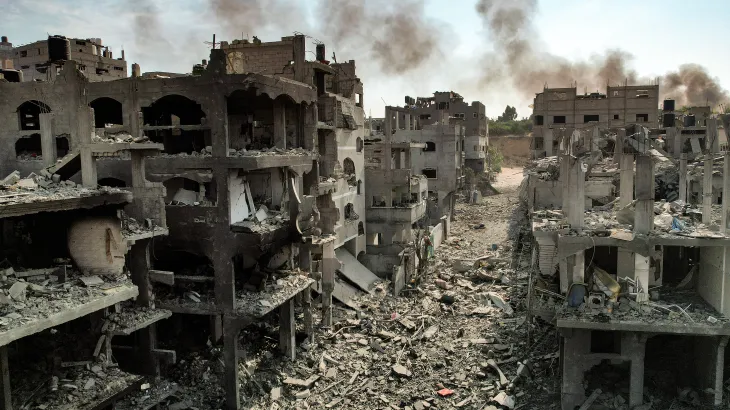Israeli Invasion Leaves Gaza in Ruins: Unprecedented Destruction, Humanitarian Crisis, and Economic Fallout

Image Source: Al Jazeera
Israel’s invasion of the Gaza Strip by land, sea, and air, which began on October 7 in response to Hamas’s cross-border attack, has caused unprecedented levels of instability and devastation in the Palestinian territory.
According to data from the Palestinian Public Works and Housing Department, the UN Office for the Coordination of Humanitarian Affairs (OCHA) reported that Israeli attacks had resulted in the destruction of over 41,000 housing units and damage to over 222,000 housing units. Overall, it stated that there had been reported damage or destruction to at least 45% of Gaza’s housing units.
Reporters from Reuters in Gaza claim that the destruction is massive, but it was impossible to independently confirm the figures. On November 12, an Israeli journalist saw Beit Hanoun in Gaza, and the Israeli military escorted him to see “barely a single inhabitable building remains standing”. Before the conflict, the population was over 52,000.
Hospitals and Schools:
According to an OCHA report dated Nov. 15, 279 educational facilities—more than 51% of the total—had allegedly sustained damage, making it impossible for Gaza’s 625,000 students to receive an education.
The Ministry of Health in Gaza reports that as of November 16, only nine of the 35 hospitals in the enclave were operating at a partially operational capacity. The remainder have stopped providing official medical care.
OCHA reported that severe drug and blood product shortages had been reported, and that 55 ambulances in Gaza had been damaged.
Water and Sanitation:
U.N. Palestinian Refugee Agency (UNRWA) reported on Nov. 16 that 70% of the population in southern Gaza lacked access to clean water due to fuel shortages.
While the two water pipelines from Israel were operational, the seawater desalination plant in Khan Younis, south of the territory, was operating at 5% of its capacity; the Israeli pipeline and the water desalination plant are not operating in the north of the territory.
The majority of Gaza’s 65 sewage pumps were out of commission; additionally, raw sewage had begun to flow in some areas of the streets.
Food Security:
According to OCHA, structural damage, a lack of fuel, water, and wheat flour, and other factors, have prevented bakeries in the northern part of Gaza from operating since Nov. 7. It stated that on November 15, Gaza’s last operational mill was destroyed.
“The situation is catastrophic,” OCHA said.
Humanitarian Aid:
Before the war, 500 trucks carrying supplies and food would arrive in Gaza every day on average. After October 7th, all imports were stopped and only started up again on October 21st. 1,139 trucks carrying humanitarian aid had entered Gaza between then and November 14.
Telecoms:
Telecommunications in Gaza ceased operations on November 16 due to a shortage of fuel for generators. According to OCHA, on November 14, multiple communication infrastructures in south Gaza were struck and damaged. Blackouts put civilians’ access to life-saving aid in jeopardy, according to OCHA. UNRWA stated that as of Nov. 17, it was unable to oversee or plan humanitarian relief convoys because of the communication outage.
Economic Impact:
About 390,000 jobs have been lost since the beginning of the conflict, according to a joint report released on November 5 by the United Nations Development Programme (UNDP) and the Economic and Social Commission for Western Asia (ESCWA).
Gaza’s socioeconomic status was already extremely bad before the conflict; in 2020, the estimated percentage of the population living in poverty was 61%. Depending on how long the war lasts, the U.N. agencies predicted that poverty would increase by 20% to 45% in their preliminary estimate. Additionally, they predicted that Gaza’s GDP would be negatively impacted by the conflict in 2023 by 4% to 12%.
Team Profile

- News Writer
- Sargam Parashar comes from an Army background and has been privileged to experience the diversity of India. She loves travelling, photography, fine arts, dancing, playing musical instruments, reading, writing, etc. Sargam is a keen learner and looks forward to trying new things. She aspires to build a career in Journalism.
Latest entries
 Defence1 December 2023Chinese Ministry of Defence Emphasizes Strengthened Ties with India Amidst Ongoing Border Standoff in Ladakh
Defence1 December 2023Chinese Ministry of Defence Emphasizes Strengthened Ties with India Amidst Ongoing Border Standoff in Ladakh Defence30 November 2023China Warns of Escalation in South China Sea Tensions, Urges Australia to Notify Navy Movements
Defence30 November 2023China Warns of Escalation in South China Sea Tensions, Urges Australia to Notify Navy Movements Defence30 November 2023India’s Defence Ministry to Discuss Landmark Fighter Aircraft Projects Worth Rs 1.3 Lakh Crore in Crucial Meeting
Defence30 November 2023India’s Defence Ministry to Discuss Landmark Fighter Aircraft Projects Worth Rs 1.3 Lakh Crore in Crucial Meeting Defence23 November 2023India and the UK Forge Strategic Partnership for Electric Propulsion in Naval Vessels, Paving the Way for Future Warship Innovation
Defence23 November 2023India and the UK Forge Strategic Partnership for Electric Propulsion in Naval Vessels, Paving the Way for Future Warship Innovation









